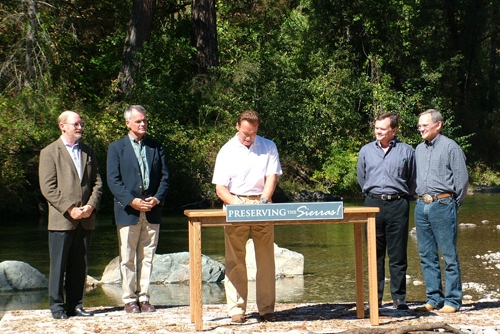Conserving our Land, Rivers, and Oceans

September 23, 2004 Governor Schwarzenegger created the Sierra Nevada Conservancy, pairing environmental protection and economic growth for the region. This 25-million-acre protected area from the Oregon border to Kern County is California’s largest conservancy. It benefits communities by providing grants to local governments for environmental protection, resource conservation, recreational opportunities, and economic growth. More than 65 percent of California’s bird and mammal species and at least 50 percent of the state’s reptile and amphibian species live within the Conservancy’s boundaries; the region produces 65 percent of the state’s water supply for residential and agricultural uses, and between 33 and 50 percent of the state’s annual timber supply comes from within the Conservancy’s borders.
October 18, 2004 The Governor unveiled his Ocean Action Plan—which set a national standard for the management of ocean and coastal resources—created the first cabinet-level Ocean Protection Council in the nation, and signed legislation to increase ocean protection, including water-quality testing and limits on trawl-net fishing.
February 18, 2005 After more than six years of planning, the Governor announced that California completed a $95 million conservation agreement with Hearst Ranch, making more than thirteen miles of pristine coastline available for public access and ensuring the protection of 82,000 acres of natural habitat—one of the largest land conservation transactions in state history. Valued at $230 million, the property includes one of the most significant coastal land gifts ever made to the State of California.
April 22, 2008 In honor of Earth Day, Governor Schwarzenegger joined with elected officials, environmentalists, and Irvine Company executives to announce that 40,000 acres of the Irvine Ranch Land Reserve was designated the first-ever California natural landmark.
May 8, 2008 Governor Schwarzenegger announced a historic agreement between Tejon Ranch landowners and conservation and environmental groups to give California its largest-ever privately conserved parcel. Under the agreement, up to approximately 90 percent of the 270,000-acre ranch will be permanently preserved. The ranch is home to California condor and countless other plant and animal species, and it includes portions of four of the state’s most important ecological regions: the Sierra Nevada, the Mojave Desert, the Coastal Range, and the San Joaquin Valley. The agreement also sets aside 30,000 acres for the development of smart-growth, sustainable communities, allowing its landowners to develop enough of the ranch to create thousands of jobs and millions of dollars in tax revenue.
July 29, 2008 Governor Schwarzenegger and the governors of Oregon and Washington released their Ocean Action Plan, outlining how the states can work together and with federal authorities to improve our ocean in seven priority areas. It included twenty-six specific actions to help combat polluted runoff and reduce marine garbage, advocate for stricter vessel emission standards, prevent invasive species, oppose new offshore oil and gas development and explore alternatives, improve ocean research, and increase ocean education.
February 18, 2010 Beginning the largest dam removal and river restoration project in America’s history, Governor Schwarzenegger joined representatives from the federal government, Oregon, and tribal leadership to announce the Klamath River Agreements. The agreements will restore what was once one of California’s largest salmon runs.
June 22, 2010 The Governor and Renova Group of Companies signed an MOU to affirm that the group will provide financial support to preserve historic Fort Ross, whose operating hours had been reduced as a result of the state’s fiscal crisis. The MOU also commits the state and the companies to promoting the fort’s historical significance.
September 25, 2010 Governor Schwarzenegger signed SB 51, establishing the Salton Sea Restoration Council as a state agency within the Natural Resources Agency to oversee the restoration of the sea. The Salton Sea, California’s largest inland body of water, is home to endangered species and supports over 400 species of birds. Its ecosystems are threatened by the water’s increasing salinity. The Governor’s action ensures that water quality, ecosystems, and the local tribal heritage will be studied and preserved.
